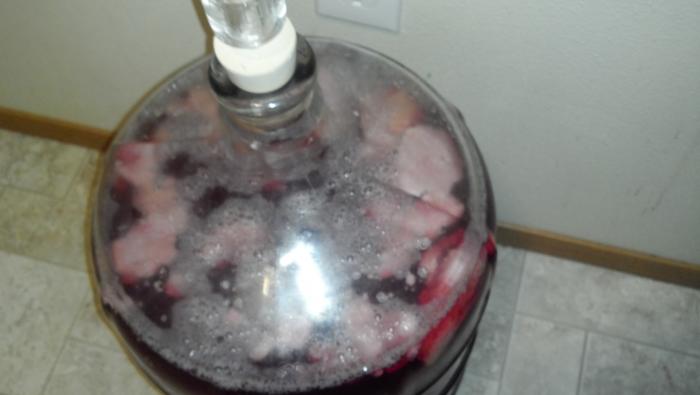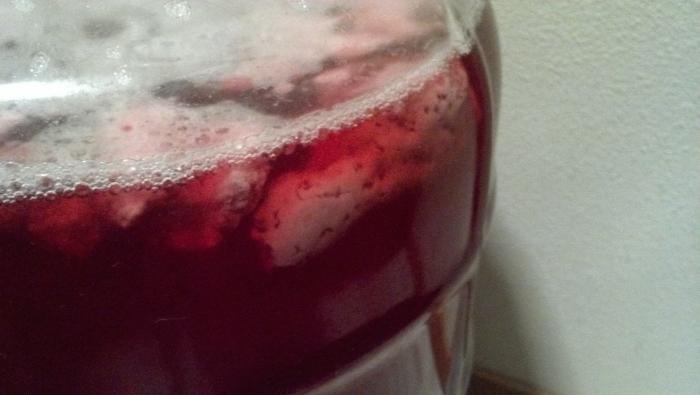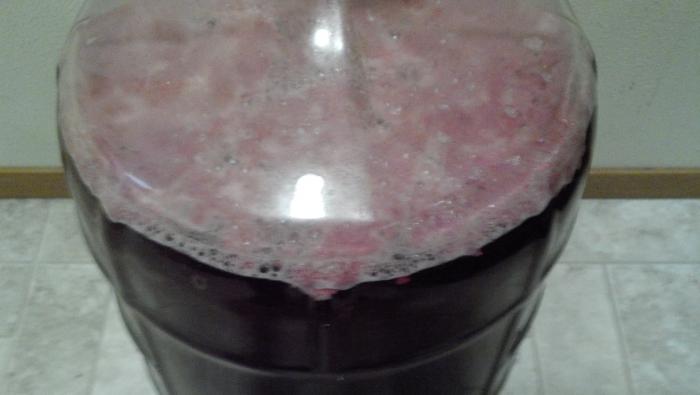You are using an out of date browser. It may not display this or other websites correctly.
You should upgrade or use an alternative browser.
You should upgrade or use an alternative browser.
Plum Wine Recommendations?
- Thread starter JPStinky
- Start date

Help Support Homebrew Talk - Beer, Wine, Mead, & Cider Brewing Discussion Forum:
This site may earn a commission from merchant affiliate
links, including eBay, Amazon, and others.
Lucky you! After you steam them dont forget to add some pectinase. Are these red fleshed or yellow? Your acid is probably going to be pretty high, go as high as you can stand, it will mellow out a bit over time. What kind of yeast and nutrients do you have on hand? We just opened a bottle of Methley plum wine, red fleshed plum, from 2006, crushed the fruit by hand, acid stung fingers, has really turned into a nice rose that I hope to make again after my fingers heal from the first batch  A little, very little bit of oak also helps give it some nice feel. WVMJ
A little, very little bit of oak also helps give it some nice feel. WVMJ
I don't know any of those words you just said.
I'm really close to a brew supply store, so I can go grab whatever it is I need. Can you recommend a yeast? Do I need to do something about the acidity? Is pectinase the same thing as pectin?
I'm really close to a brew supply store, so I can go grab whatever it is I need. Can you recommend a yeast? Do I need to do something about the acidity? Is pectinase the same thing as pectin?
saramc
Well-Known Member
Pectin is used to thicken jam/jelly, you use pectinase/pectic enzyme to break the fruit down, get more juice, prevent a pectin haze; definitely not the same thing, do not ever add pectin to wine unless you are making jelly (wine jelly rocks). And any time you heat the fruit you risk 'setting the natural pectin', so you want to be sure not to skimp on this enzyme when you steam juice. Your LHBS should have all the basics to get you started.
I would not recommend boiling your fruit. Outside of adding hot water to a dried fruit very rarely would you ever want to cook/boil your must. You can pour boiling water over fresh fruit to scald it and in essence hope to kill off any bugs, the ones you can & cannot see.
Plum wine made from all-fruit no added water should be quite nice. When you steam juice you are pasteurizing at the same time, so you can literally store this hot juice in glass canning jars until ready to use, as long as your jars were clean/hot, etc..ie canning process. But your juice is just waiting to have its SG taken, some sugar to reach SG around 1.090, 12% ACV, plus pectinase and yeast nutrient, wait 12-24 hrs and add potassium metabisulfite aka Campden or K-meta/KMS, wait 12-24 hrs and pitch your yeast. Read your pkg labels, they tell you how much to add per gallon, amounts can vary per manufacturer.
As you get more experience you will find that many freeze/thaw the fruit for 1-2 cycles and then start the winemaking process since freeze/thaw will expand/rupture the fruit cell walls giving you more of a yield on juice, even when steam juicing. Then the addition of pectinase increases that yield..all without water being added.
As mentioned plums can be acidic, and it really is ideal if you can check the pH. A digital pH probe is better than pesky paper strips, and a basic hydroponic/fish tank digital pH monitor will get you started, el cheapo $8-15, just be sure to calibrate the thing. You can also buy acid test kits at most LHBS or online which check another acidity component, called TA, titratable acidity. You can deal with pH/TA in different ways at different times, come back to us with your numbers. But buy some calcium carbonate(aka chalk) and potassium bicarbonate(I prefer k-bicarb) when you get your supplies, as these are among your options. Better buy a 2nd hydrometer if you can, they break at the most inopportune moments. Grab some acid blend too, or one malic acid + one tartaric acid & you can make your own acid blend if/when needed. (And in about 9 months you will need potassium sorbate, if you plan to sweeten the wine up.)
Since the dominant acid in plums is malic you may want to consider a wine yeast known to metabolize malic acid, like this one http://www.lalvinyeast.com/71B.asp, it has a temp range of 59-86F and an ACV threshold around 14%.
If you have not yet read over some basics in winemaking, terms, process, etc. I highly recommend starting with www.winemaking.jackkeller.net, he gives a great overview, has sections for beginner to advanced, recipes and a blog. Very informative.
Question: how many pounds or gallons of plums did you steam juice to get 5 gallons of juice?
I would not recommend boiling your fruit. Outside of adding hot water to a dried fruit very rarely would you ever want to cook/boil your must. You can pour boiling water over fresh fruit to scald it and in essence hope to kill off any bugs, the ones you can & cannot see.
Plum wine made from all-fruit no added water should be quite nice. When you steam juice you are pasteurizing at the same time, so you can literally store this hot juice in glass canning jars until ready to use, as long as your jars were clean/hot, etc..ie canning process. But your juice is just waiting to have its SG taken, some sugar to reach SG around 1.090, 12% ACV, plus pectinase and yeast nutrient, wait 12-24 hrs and add potassium metabisulfite aka Campden or K-meta/KMS, wait 12-24 hrs and pitch your yeast. Read your pkg labels, they tell you how much to add per gallon, amounts can vary per manufacturer.
As you get more experience you will find that many freeze/thaw the fruit for 1-2 cycles and then start the winemaking process since freeze/thaw will expand/rupture the fruit cell walls giving you more of a yield on juice, even when steam juicing. Then the addition of pectinase increases that yield..all without water being added.
As mentioned plums can be acidic, and it really is ideal if you can check the pH. A digital pH probe is better than pesky paper strips, and a basic hydroponic/fish tank digital pH monitor will get you started, el cheapo $8-15, just be sure to calibrate the thing. You can also buy acid test kits at most LHBS or online which check another acidity component, called TA, titratable acidity. You can deal with pH/TA in different ways at different times, come back to us with your numbers. But buy some calcium carbonate(aka chalk) and potassium bicarbonate(I prefer k-bicarb) when you get your supplies, as these are among your options. Better buy a 2nd hydrometer if you can, they break at the most inopportune moments. Grab some acid blend too, or one malic acid + one tartaric acid & you can make your own acid blend if/when needed. (And in about 9 months you will need potassium sorbate, if you plan to sweeten the wine up.)
Since the dominant acid in plums is malic you may want to consider a wine yeast known to metabolize malic acid, like this one http://www.lalvinyeast.com/71B.asp, it has a temp range of 59-86F and an ACV threshold around 14%.
If you have not yet read over some basics in winemaking, terms, process, etc. I highly recommend starting with www.winemaking.jackkeller.net, he gives a great overview, has sections for beginner to advanced, recipes and a blog. Very informative.
Question: how many pounds or gallons of plums did you steam juice to get 5 gallons of juice?
You know... I get so used to places like Facebook that I forget that there are genuinely good, helpful, people on the internet. Thank you so much for your timely help. I'm headed to the brew shop tomorrow with a printout of this thread so the owner can help me find some materials.
I'm not sure the exact amount, but I know I filled a 5 gallon bucket, plus partially filled a large plastic container that my kids use for toys. My guess is about 10 gallons of plums. Also, this was my first time steaming, so I just shut it off when they looked done, not sure if it should have been longer.
I'll be back with SG and pH numbers!
I'm not sure the exact amount, but I know I filled a 5 gallon bucket, plus partially filled a large plastic container that my kids use for toys. My guess is about 10 gallons of plums. Also, this was my first time steaming, so I just shut it off when they looked done, not sure if it should have been longer.
I'll be back with SG and pH numbers!
I went to the LHBS, and grabbed some supplies. I added pectic enzyme as well as "juice bacteria killer" (the same stuff that kills the yeast before you bottle)
Waiting 24 hours to add my Red Star Yeast. I noticed that the juice is separating, purple on top, peachy on the bottom. Anyone ever seen that?

Waiting 24 hours to add my Red Star Yeast. I noticed that the juice is separating, purple on top, peachy on the bottom. Anyone ever seen that?

StoneArcher
Well-Known Member
Wow, is that beautiful! Must have been a red meat plum? How much PE did you add and what Red Star yeast are you planning on pitching? Did you pick up a hydrometer and a wine thief yet? Looking for a gravity reading is all.
I used 3 tsp of PE. (Directions said 3/4 per gallon, but it sounds like I don't need as much since I steam juiced). The brewmaster at the shop recommended Red Star Premiere Cuvee. I grabbed a hydrometer and I was planning on finding SG tomorrow before I add the yeast. I was told to get it close to 1.090 (Add water to lower it, Add sugar to raise it, right?
Am I supposed to aerate this like beer?
Am I supposed to aerate this like beer?
StoneArcher
Well-Known Member
I always giver a shake or stir the first few days, air helps yeast do its thing.
Good call on upping the PE. According to Luc, more the merrier.
1.090 is a good start. I just did mine at 1.115, pitched Montratchet; hoping for a semisweet finish.
You are correct on the up and down for SG.
Good call on upping the PE. According to Luc, more the merrier.
1.090 is a good start. I just did mine at 1.115, pitched Montratchet; hoping for a semisweet finish.
You are correct on the up and down for SG.
JPS, now I dont recognize your words  What is the juice bacteria killer and why would you add something that would kill your yeast before you add your yeast? I think you might mean potassium metabisulfite, it knocks down most bad yeast and bacteria, wine yeast it doesnt kill, otherwise adding it at the beginning would be a bad thing. I am hoping you didnt mean potassium sorbate which inhibits yeast growth but doesnt really kill it off. Please be more specific in what is was that you added. If you added sulfite you are good to go, if you put in sorbate you are in trouble. WVMJ
What is the juice bacteria killer and why would you add something that would kill your yeast before you add your yeast? I think you might mean potassium metabisulfite, it knocks down most bad yeast and bacteria, wine yeast it doesnt kill, otherwise adding it at the beginning would be a bad thing. I am hoping you didnt mean potassium sorbate which inhibits yeast growth but doesnt really kill it off. Please be more specific in what is was that you added. If you added sulfite you are good to go, if you put in sorbate you are in trouble. WVMJ
I went to the LHBS, and grabbed some supplies. I added pectic enzyme as well as "juice bacteria killer" (the same stuff that kills the yeast before you bottle)
Waiting 24 hours to add my Red Star Yeast. I noticed that the juice is separating, purple on top, peachy on the bottom. Anyone ever seen that?
You have a hydrometer now, you are free from recipes now! Keep adding sugar to you reach YOUR target. Since you steamed these there is not much oxygen in the must (hot water doesnt have a lot of oxygen), whip it up good. WVMJ
I checked, it IS Potassium Metabisulfite. Brewshop guy told me that it kills bacteria and yeast, so add it to the must, then wait 24 hours so it doesn't kill YOUR yeast. He also told me that you add it before bottling to kill your yeast so your wine does not ferment in the bottles. (Accurate?)
Anyway, I had to run to the store to grab another bag of sugar, which I used all of. So right about 6 lbs of sugar, but I am right at 1.090 SG.
Anyway, I had to run to the store to grab another bag of sugar, which I used all of. So right about 6 lbs of sugar, but I am right at 1.090 SG.
No, it wont kill your yeast, if you have sugar left in the wine when its done you should add potassium sorbate, this stops the yeast from dividing and fermenting your wine in the bottle, the KM keeps the bacteria and wild yeast under control AND helps preserve the color of your wine by protecting it from oxigination. So they are sorta right but not specific enough. We dont want you to have your corks pop out after you bottle this batch. WVMJ
StoneArcher
Well-Known Member
Anyway, I had to run to the store to grab another bag of sugar, which I used all of. ...
If you are going to be making wine with any frequency, just back the Domino or C&H sugar truck up and unload.
Best of luck, I look forward to hearing reports on your samples.
I have not seen much activity and I was hoping for some input. A few days ago I pitched the yeast (with 5 tsp of nutrient). I read that I am supposed to keep my carboy open (I have the airlock on, but no cap and no water) and to stir it everyday.
On the first day, SG was 1.090, but I had about an inch of brown liquid on top. Mixing got rid of it.
Ever since then, I've been mixing every day. SG has dropped to 1.080, other than that, no change. I've added more nutrient and more yeast.
Any suggestions?
On the first day, SG was 1.090, but I had about an inch of brown liquid on top. Mixing got rid of it.
Ever since then, I've been mixing every day. SG has dropped to 1.080, other than that, no change. I've added more nutrient and more yeast.
Any suggestions?
What are you expecting it to do? It dropped 10 points. Dont just keep adding more nutrient, you can add too much and make things taste funny. Did you proof your yeast first or just add it in? Drop by the wine supply store again and get a wine thief. You can stick it thru the cap of junk on top and it will fill with wine and when you lift it it will seal itself, if you put your hydrometer in there you can get a true reading without the junk interferring. What temp you got this at? WVMJ
Oh, is 10 pts normal? From the reading that I've been doing, it sounded like it was supposed to be dropping a lot within the first week, then slowly after that. I'll grab a wine thief next time I'm close to LHBS. It is not being temperature controlled, it is just sitting in my kitchen, so around 65-70 F.
Oh No!
I have a theory (as someone who doesn't know what they are talking about). I think my yeast had trouble getting started due to poor aeration. When I went back and aerated it, I started seeing activity. There was about and inch of lees on the bottom of the carboy. When it broke up and floated to the top, some of the pieces held the shape that they were in. After a day, the big chunks dissolved. Does the last picture look infected to you?
If so, is there anything I can do to save it?
I have a theory (as someone who doesn't know what they are talking about). I think my yeast had trouble getting started due to poor aeration. When I went back and aerated it, I started seeing activity. There was about and inch of lees on the bottom of the carboy. When it broke up and floated to the top, some of the pieces held the shape that they were in. After a day, the big chunks dissolved. Does the last picture look infected to you?
If so, is there anything I can do to save it?
It doest look like an infection, I think steaming might sometimes coagulate proteins and other stuff you wouldnt normally see if you fermented raw fruit. If it was infected it would not smell very good now. Just stuff from the fruit collecting at the top, dont worry about it. Is your gravity still dropping? WVMJ
Slowly but surely, gravity is dropping. It's down to 1.065 now. I keep reading different things about racking. Some places say don't rack until SG 1.020. Other places say to rack it off the lees after 3-4 weeks. Any thoughts?
it looks odd to me, maybe it isn't infected. I have had similar things happen to me with fruit wines but they were mainly foam and didn't look alien like that...who knows fermentation can be crazy sometimes and maybe I did jump the gun on this one. Anyways, rack when the gravity gets between 1.020 and 1.010 but don't let it get below 1.010 if that makes sense. Good luck, sorry if I scared you it just doesn't look normal to me.
Trying not to scare the newbies is a big goal, especially if they have stinky in their name. Two things that we need to follow up on this post, JP is a newbie, and it does look weird, but he steamed them which for a newbie and anyone else can produce some oddities from time to time. Also the 1.010 thing about racking, its not a bad number to rack at but the wine is supersaturated with CO2, you can easilly let it go dry without it going bad, just not let it set so long your loose your CO2 blanket on top.
WVMJ
WVMJ
I twirled it, then let it sit for a few minutes before I took that picture. SG yesterday was down to 1.004.
Question: If I want it to keep some of its sweetness, do I add Potassium metabisulfite when it reaches 1.000? Or should I just let it ferment, then backsweeten it before bottling? I've searched the internet and can't seem to find a straight answer on this.
Question: If I want it to keep some of its sweetness, do I add Potassium metabisulfite when it reaches 1.000? Or should I just let it ferment, then backsweeten it before bottling? I've searched the internet and can't seem to find a straight answer on this.
Everyone has a straight answer for this. What would the KM do? If you think its going to stop the yeast it wont, it will keep right on fermenting. Your safest bet is to let it finish, then after its clear stabalize with KM and sorbate and backsweeten. WVMJ
I wanted to make sure to update everyone on the finished product here. The plum wine came out very nice. Several of my friends really enjoy it, while others didn't care for how different it was from grape wine. The person who donated the plums to me over the summer has the last name "Drake", so we decided to name the wine "Pink Drake." A gifted local artist made a label for me. The picture below is the bottle that I am giving to Miss Drake for Christmas.
Thank you all for all the support you have given me in my first attempt. This was a triumph.
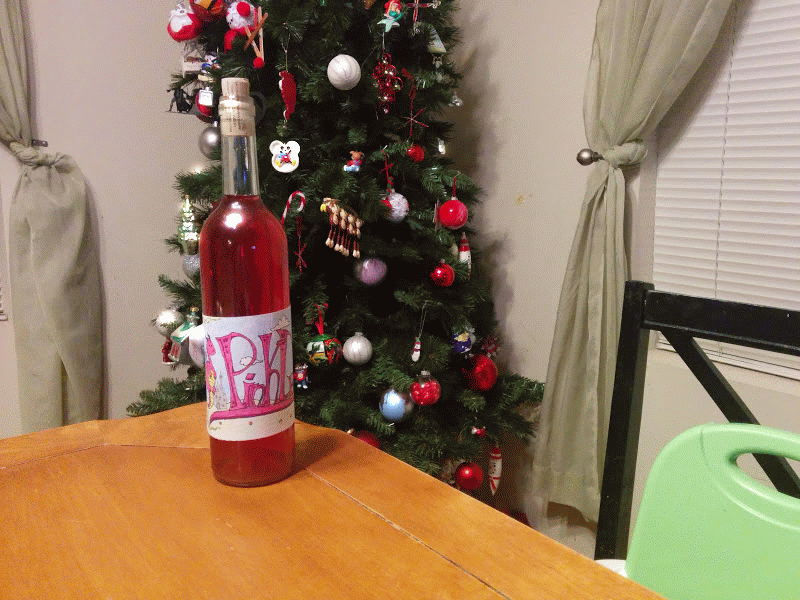
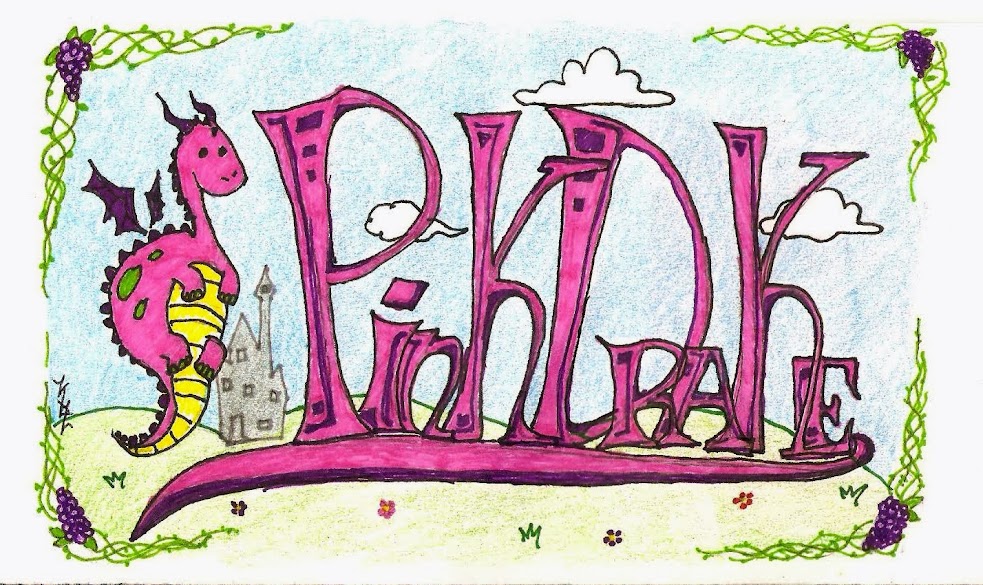
Thank you all for all the support you have given me in my first attempt. This was a triumph.


Similar threads
- Replies
- 3
- Views
- 593
- Replies
- 15
- Views
- 1K
- Replies
- 2
- Views
- 653

